BURES MILL OVER NINE CENTURIES
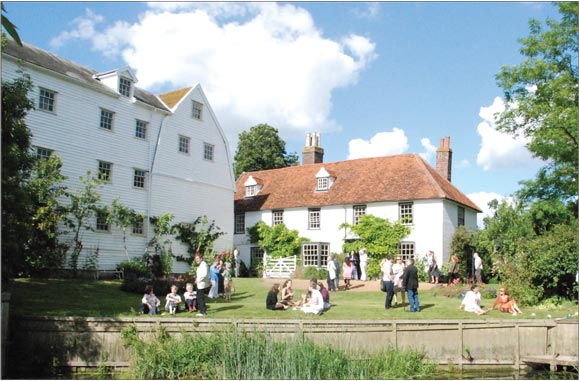
Bures Mill and the Mill House.
In March 1994 a bad tooth led to the good fortune of finding Bures Mill. While waiting at my dentist’s in Highgate I picked up a two year old copy of ‘Country Life’ and found a mill on the Stour advertised for sale. As I was born at Mistley and brought up on the river Stour, I was fascinated, and I immediately contacted Roy Chapman, the estate agent, who told me that, surprisingly, after two years Bures Mill was still for sale.
We went to meet Witgar Hitchcock, the owner, at the Mill on 1st April, a beautiful spring day, and he proudly showed us over the Mill, the house and the lovely old garden with its great variety of fruit trees. Mr Hitchcock had been born and brought up at the Mill, as had his father before him. He was keen to tell us the long history of the Mill and of his family’s association with it over nearly one hundred and twenty years, since his grandfather, Cornelius Hitchcock, became the miller in 1875.
Though we were anxious about the enormous modern buildings which would have to be demolished, we fell in love with the Mill and offered to buy it. Mr Hitchcock seemed taken aback; perhaps he was sad to part with the house, where he was born, and the Mill, where he had worked all his life. To our amusement, however, he took the precaution of looking up the Temple family in the Directory of Mistley of 1935 and finding that my parents seemed respectable and had been resident at Dorset House. He obviously felt reassured that we were a suitable family to take on Bures Mill, as we completed the purchase a few weeks later.
There has been a mill on this site for at least the past thousand years. The earliest story of its inhabitants was a favourite of Witgar Hitchcock. One of the first stories he told us was about the Anglo Saxon miller who, at the time of the Norman conquest, patriotically sabotaged the Mill by throwing the mill stones into the deep floodgate pond.
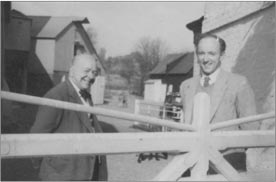
Witgar Hitchcock on his retirement in 1992. It shows the absestos-clad Mill in the background.
The Domesday Book of 1086 records two watermills at Bures. Leigh Alston, our local Bures historian, holds the opinion from his reading of the Domesday evidence, that the Anglo Saxon mill might have been elsewhere in the village. On the ground, however, it appears more likely that the Saxon Mill was situated to the south of the site of the present mill house and the county archaeological map suggests this. Recent evidence from excavations to build a conservatory, when traces of a building were found, suggests that the site may have been some ten yards south of the mill house, where the floodwater still runs and delineates the possible course of the Anglo Saxon mill leat. The Anglo Saxon mill would have been on a much smaller scale than the Norman mill and only harnessed part of the flow of the river. It may have been similar to a small crud mill or cheese mill, which was situated about three-quarters of a mile down the river, and in medieval times processed the famous local sheep’s cheese. There is still a “crud mill” meadow on the site near Staunch Farm, Mount Bures. The owner of the Bures Mill was recorded in the Domesday Book as a Saxon landowner by the name of Witgar. It is remarkable that the last miller at Bures Mill, Witgar Hitchcock, should have been romantically named after Witgar the Saxon mill owner.
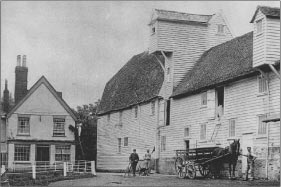
This view shows the Tudor Mill on the right of the picture, which was largely demolished in 1962. It shows the Mill cart and horse of that period. c.1900.
A century after the Conquest in 1066, in the middle of the 12th century, the Norman Sylvester family were responsible for building a new mill at Bures. They began a large scale diversion of the river to the north, leaving the old Anglo Saxon course of the river to the south. The course of the river was shortened and taken more directly to the site of the new Mill. This required a cutting of four hundred yards and must have involved a large workforce.
When the river was dredged in 1968, geological differences were noticed; the bed of the river cut by the Normans was different from the bed of the river higher up stream. The ancient course of the river is still visible in the ditch, which has some large pools in it and runs alongside the field upriver of the Mill, and this forms the county boundary between Suffolk and Essex, which has not been altered since Saxon times. By 1462 this ditch was known as Le Oldestore. Between it and the new course of the river, there is an island of about an acre known as the Wooping, which is a favourite haunt of otters. The ancient course of the river is still visible in a ditch which runs through the field upriver of the Mill and fills with water only in heavy rain. This old course of the river was opened up in 2010 by the Environment Agency as a European Union project as a by-pass for elvers, so that after 800 years water is again flowing in the Anglo Saxon river. Elvers have suffered an enormous decline and are a threatened species as a result of overfishing due to their reputation in Spain as an aphrodisiac.
The Norman Mill was able to harness the great power of the river. It was a long building standing to the north of the present mill building and had an open water wheel on its south side. Later building extended the Mill to the south and enclosed the wheel.
On his marriage in 1329, Robert de Bures took over the ownership of the Mill. At that time the Mill had three waterwheels: one main wheel drove the corn mill and there were two other water wheels in the building. One of these drove a fulling mill, which dressed the woollen cloth that was woven locally, and the third one ground malt for making beer. The meadow to the south of the Mill was called the Tenter field on old maps, as this was where the woollen cloth was pegged out to dry after the fulling process had been completed. The medieval Common Meadow of Mount Bures Manor was immediately across the river from the Mill and was allocated in strips for haymaking by the Lord of the Manor to the villagers of Mount Bures. The old manorial maps show that eighteen strips were allocated. This was carried out each year and only ended in 1860 when the meadow was sold from the manor. It now provides grazing for our flock of black Hebridean sheep and small herd of Suffolk Red Poll Cattle. There is local evidence of Bronze Age circles and linear features, which show as crop marks, and which were the sacred burial places of Bronze Age chieftains.
Manorial account rolls, written on vellum in Norman French, exist for the manor for 1384/5 1410/11 1428/29 and 1438/39 and have been researched by Leigh Alston. In 1384/85 the Mill was no longer part of the manor home farm but was let out to on a lease to an independent miller. In 1439 Stephen Cokerell paid 10 sticks of 24 eels to the manor of Netherhall as part of the rent for his tenancy of the Mill. In the same year, in the reign of Henry VI, detailed accounts are given for extensive repairs to the Mill including mending the water wheels with oak timber cut from the lord’s demesne. A large number of carpenters, sawyers and labourers were employed to mend and reinforce the millpond and the mill leat with oak timbers and rammed clay. In total, 1,666 feet of timber was used. One bay remains of the 16th century Mill. Sadly, most of the rest of the building was demolished in 1963 to make way for a modern milling plant. This bay survived because it supported the Lucam above it, which contained a hoist to lift sacks into the Mill. Leigh Alston surveyed this part of the building and found evidence of a mullioned window facing south above the water wheel as well as original posts and studwork. He noticed that the structure was very similar to the manorial court building at Ferriers barn, built by the Waldegrave family in the 16th century, who owned the Mill as part of the manor, and he believed it was built by the same master carpenter. The Waldegraves built both Smallbridge Hall and Bevills in the parish of Bures St Mary in the 15th Century. I’m grateful to Leigh Alston for his help in researching the history of this period.
The Mill House dates from 1650 and so was built in the interregnum during Oliver Cromwell’s rule. With its fourteen inch brick walls it was a very warm house in winter. The 1650 attic bedrooms were designed for housemaids; one contained a bell connected by wire to a bell pull in the bedroom of the mistress of the house. Little is known of the millers of this period.
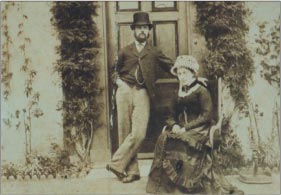
Cornelius Hitchcock and his wife on arrival at the Mill in 1875.
During the 18th century the Mill was leased to John Constable’s grandfather, who was also called John Constable. The Constable Family had many connections with Bures and Wormingford and the artist’s Father, Golding Constable, spent part of his childhood in Bures. The river was opened to navigation in 1713 by the Stour Navigation Company, which enabled barges to transport corn to the Mill. Canadian wheat was used for grinding into flour, which arrived by barge from Mistley. The Stour Lighters, which so often appear in John Constable’s pictures, were pulled in pairs or gangs by one sturdy horse. The horse had to be well trained as it had to jump the gates on the towpath and hop onto the barge to get across the river when the towpath changed sides, as it did four times in Bures. Fully laden, the two barges could carry 50 tonnes, and the journey from Mistley to Bures took one and a half days. According to Witgar Hitchcock, the last barge came to Bures from Mistley in 1913. In 1914 all of the Stour barges were sunk in Ballingdon Cut at Sudbury. They were apparently sunk because of the fear that they might be used in a German invasion. In the 1980s one of these barges was dug out of the mud and partly restored. This barge, named the John Constable, is undergoing complete restoration at the Pioneer Sailing Trust at Brightlingsea, a project funded by the Heritage Lottery Fund. It is hoped that when the restoration is complete in 2012, the John Constable will operate on the River Stour at Flatford, no longer pulled by a horse, but powered by electric motors.
Water in the early years was the only and obvious source of power to turn the massive water wheel, which was 16 feet in diameter and 10 feet wide, driving four pairs of stones.
The Stannard family who also ran Wiston Mill leased the Mill in the early part of the 19th century. The Mill was greatly extended in 1820 to increase its capacity to use imported hard wheat coming up the river from Mistley by barge. The Mill house was also much enlarged at the same time. These extensions were paid for by the prosperity brought to the Mill by the Napoleonic Wars, when there was an agricultural boom and, no doubt, also due to the skill of the Stannards as millers, who extended Wiston Mill at the same time.
The Mill remained the property of the manor until 1860 when it was sold to Mr Cooper. Mr Cooper installed a steam engine in 1867 with a large chimney for the boiler. This was a large beam engine which augmented the water power. Newcastle Coal for the steam engine was brought up to the Mill by barge from Mistley as well as for the Bures gasworks.
The Hitchcock Family 1875-1994 I am grateful to the late Witgar Hitchcock for all the details of his family’s history, which he generously gave us, and for the many historical photographs he provided.
He often came to see us to inspect restoration progress, especially before Christmas when he came to cut holly from his favourite tree across the river from the Mill. He remarked somewhat reproachfully that he had been trying to bring the old place up to date and we had taken it back a hundred years! But, generally, he approved our restoration work and efforts to be faithful to the Mill’s history. There are many tales in the village of his formidable mother, Mrs Hitchcock, a JP and an early feminist as well as a Liberal councillor, who frightened not only the village boys but also the gardener. He was not allowed to use manure to fertilise the garden and, no doubt, there were many other strict rules. She believed that the flood brought down nutrition for the soil, just like the Nile in Egypt.
Cornelius Hitchcock purchased the Mill in 1875 and the fine Mill at Wormingford in 1879. Sadly it burnt down in 1929 when the oil engine set it on fire. The fire nearly burnt the paintings of John Nash, who rented a cottage adjacent to the Mill. Cornelius’s greatest achievement was in changing over from stones to roller flour milling at Bures in 1893. Instead of producing wholemeal flour on stones, the new Hungarian system of roller flour milling produced the white flour demanded by the public. The roller mill, made in Dresden, still remains in the building.
At one time on the Stour and its tributaries there were 30 mills producing flour. Only three changed to roller milling, which extended their life span considerably. The three were Dedham (flour milling, closed 1982), Bures (animal feed, closed 1990) and Cornard (dog food) which is still in existence, although production has been moved to the site on the Industrial Estate at Sudbury.
Scattered about East Anglia in recent centuries was a network of families engaged in flour milling. When Cornelius Hitchcock came to Bures Mill in 1875, he was a man of twenty three, the son of a farmer at Hitcham in Suffolk, where the rector had been the Reverend J S Henslow. Henslow had been Professor of Botany at Cambridge, and numbered amongst his students was Charles Darwin, whose voyage on the “Beagle” Henslow had arranged.
Cornelius did not stay with his father John on the farm, but went off to learn his trade as a miller at the windmill at Buxhall owned by a relative named Isaac Clover. He subsequently went on to the Water Mill at Sudbury as an “Improver” with another member of the Clover family. The old Mill at Sudbury is now the Mill Hotel where the mill wheel is still kept turning in the dining room. For a short period Cornelius ran the small mill at Lawford before coming to Bures.
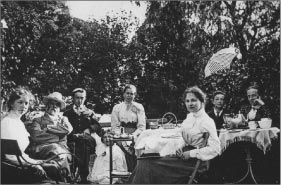
Cornelius Hitchcock and his family having tea on the lawn by the millpond, 1895.
When Cornelius Hitchcock took over Bures Mill it had already ceased to be totally dependent on the water wheel and was using a steam engine for auxiliary power. The tall chimney can still be seen in old photographs but was demolished in about 1900. The steam boiler was very handy for warming the Mill House and its greenhouse. The steam pipes can still be seen in the walls of the house. The water wheel, as with other Suffolk mills before the arrival of mains power, was used to generate electricity for the house, which was stored in 50 volt batteries.
At the time of the 1881 Census, when Cornelius Hitchcock and his wife had spent six years at the Mill House, there were ten people living there: Cornelius and his wife, their four daughters Nell, Grace, Ester and Emma, two maids and two apprentices. In the Mill, ten men and three boys were employed. After 1881, five sons followed the four daughters: John, Manfred Cooper, Alan Flinders, and Cornelius Franklin (who died at the age of six months). They also had a fifth daughter named Olive. It was a notable achievement to have reared, in those days, eight out of the nine children born to them. All the family are shown in the fine photograph taken in 1895 of tea on the lawn by the mill pond.
The 20th Century brought immense changes to the ancient mill. The steam engine installed in 1867 was replaced by a suction gas engine about 1900. The generation of electricity by dynamo began in the early years of the twentieth century. In 1932 power came from a diesel engine, and by 1948 all the mill machinery was worked by electricity. Many new buildings were built of steel and asbestos to accommodate the milling machinery and these dwarfed the old buildings. A 70ft grain silo was constructed on the foundations of the old maltings.
Cornelius’ grandson Witgar has charmingly described life in those early days: “Fewer and fewer people can now visualize a homestead where water was pumped up twice daily from a well below the scullery floor. Electricity was made on site and stored in batteries at 50 volts, which were topped up on winter Sunday evenings by running the water wheel.
“All classes of livestock were kept up until 1920; carthorses, ponies, house cows, pigs, chickens and ducks as well as bees. In the 20s and 30s there were only pigs, poultry and, of course, shooting dogs, but these were joined for the period 1940 – 1955 by Jersey House cows. Butter was once again regularly made, and hams, chaps and sides of bacon were pickled in lead-lined pickling troughs before being coated with essence of smoke (pyroligneous acid).
“In earlier times, say until 1875, malt was made in the maltings at the base of what was the grain silo, and the beer was brewed in the ancient building called the Brew House.” (When the Brew House was restored recently, it was found to have been repaired with naval ships’ timbers, dated 1792.) “The beer was stored in casks in the dairy (which is now the dining room). These casks were connected in turn by pipes to the Mill so the men could each draw a pint before starting work. No doubt they needed plenty of liquid refreshment working in the dusty conditions of the Mill.”
“My father would often take advantage of bad weather, in the depth of winter, to walk down by the river for a mile or so with gun and dog and return with a brace of widgeon or occasionally snipe. The cleaner and deeper river of earlier days was also good for fishing, particularly for bream. My father and a friend would go out all night in the boat, and on one such occasion, in August 1913, they got several bream, three weighing six pounds each. Tench was regarded as the finest fish in the river and these were most likely to be caught in June. Of course, in those days, what was caught was for the table.” “Eels were a commercial proposition. They could be netted as they came through the floodgate as the water became increasingly muddy on a dark summer night, following heavy rain. A violent storm early in August 1915 came just right, and the following evening four stone of eels were easily caught. In World War II the floodgates had gone but eels were regularly caught in a trap set in a little arch at the tailwater of the Mill. Packed in special boxes, they were despatched by the first train from Bures and arrived at Liverpool Street station in time for the daily morning auction at Billingsgate.”
“Then there was the garden. Tea would be the only meal taken outside in Victorian days. A special round iron table was made with uneven legs to take account of the sloping side lawn which was favoured for this. A full-size greenhouse with a vine was heated by hot water from the Mill’s steam engine. At the bottom lawn was a summer house in which Victorian daughters of the house did their embroidery on sultry summer afternoons. Among the trees in the garden were two fine and large D’arcy Spice apple trees, a Norfolk Beefing and an Iron Pear. Along the banks of the river, charcoal willows were planted on a commercial basis until the 1920s, when they were superseded by cricket bat willows.”
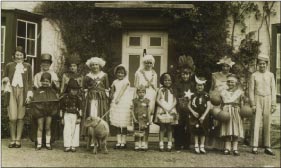
Bures village fete at the Mill in 1933.
We have extended Mr Hitchcock’s orchard and planted many local old varieties of apples and we have also replaced the D’arcy Spice trees which were blown down in the 1987 hurricane.
The Hitchcock family were very proud of their ancestor, Matthew Flinders, who was one of Captain Cook’s Lieutenants (together with Bligh and Vancouver on his first voyage of discovery in HMS Endeavour).
Flinders surveyed much of the coast of Australia in 1803 and is a national hero in Australia. On his return voyage, he had the misfortune to be captured by the French and imprisoned for five years in Mauritius. His remarkable achievement is commemorated by a bed in the lawn by the millpond, which is cut in the shape of the continent of Australia. As it is on a slope by the river, we use the Australia bed to measure the height of the floods. A flood which reaches Tasmania is modest, but if Sydney goes under we become concerned and when Darwin gets wet we start to think of putting the furniture upstairs!
In 1932 the mill wheel was removed and replaced by a 220hp diesel engine. However, within a year, all flour milling was transferred to Fingringhoe Mill (a tide mill on the Roman river also owned by the Hitchcocks) to take advantage of transport for imported corn by ship and barge. Soon Bures Mill was concentrating on animal food production alone.
In 1935, three feet of water was lost from the river following the breakdown of the floodgates at Wormingford Mill. The gates were never re-installed and the river has never regained this full height since.
In 1948, mains electricity came to the Mill and this allowed larger machinery to be installed.
As production of animal feed increased, the buildings were extended three times, in 1957, 1963 and 1980. During the last extension, a second production line was installed and by 1989, 64 different types of animal feed were produced.
However, the great changes in agriculture, culminating in the almost total demise of mixed farming, led to the collapse of its market. Production fell sharply between 1984 and 1989, with the result that the business was sold to Clark & Butcher of Soham.
1990 was the last year of animal feed production at the Mill, and the end of three generations of milling by the Hitchcock family over a period of 115 years.
The buyers purchased only the stock and business of the Mill, so consequently it was put up for sale. After buying the Mill, we obtained planning permission to demolish all the modern steel and asbestos buildings attached to the Grade 2 listed timber Mill, and to remove the asbestos cladding from the ancient mill and restore it. We were able to reuse the salvaged timber from the modern buildings to re-clad and rebuild the damaged parts of the ancient mill. This leaves the 16th, 17th, 18th century and 1820 buildings intact and in good condition. Despite a number of possible plans, we have not so far found a modern use for the mill buildings, apart from incorporating a hydro-electric plant in part of them. We are working on a plan to replace the water wheel so that the Mill could again harness the power of the river to generate hydro-electricity. A similar project is well advanced at Flatford Mill, using an Archimedes Screw. The average flow of the Stour at Bures is two and a half tonnes per second, and this flow of the river could power a 17.5 k/w generator producing enough electricity to provide for about 25 houses. The water company is planning to increase the flow of the river Stour by increased pumping from the Great Ouse at Denver. The water will be pumped from Wormingford to Abberton Reservoir. So, after many years of inactivity, the Mill could resume its active life and make a contribution to providing green power to combat climate change. This follows in the tradition of Cornelius Hitchcock, who installed a generator attached to the water wheel in the 1890s which enabled the Mill to be one of the first houses to have electricity in Bures. The use of the Mill to generate hydro-electricity would also require opening up the tail-water pool and the mill leat and would further restore the mill to its 19th century condition, when it was a very beautiful building as viewed across the tail-water pool.
We also plan to rebuild part of the Tudor Mill, which stands on the site of the original Norman Mill built in the 12th century. We hope to set up a small museum to record Bures Mill’s long and interesting history. We have greatly enjoyed restoring the Mill, the mill house and the garden. It is very rich in wildlife, including otters, water voles and numerous badgers. Among the many species of birds are herons, egrets and reed and sedge warblers. The reed warblers are accompanied by a unique strain of cuckoos, who can lay a perfect copy of their eggs. We are most grateful that Witgar Hitchcock decided that we were worthy successors of the Hitchcock family at Bures Mill.
Nicholas Temple
Nicholas and Elizabeth Temple have done some amazing work on the Mill, and obviously want to do more. Nick is a psychiatrist and psychoanalyst, who has been interested in talking treatments in mental health. He retired in 2008 from the NHS when he was Chief Executive of the Tavistock and Portman NHS Trust. Nick is currently President Elect of the British Psychoanalytical Society in London and continues his clinical practice and teaching. His wife, Elizabeth, is also a child psychiatrist and pyschoanalyst.
